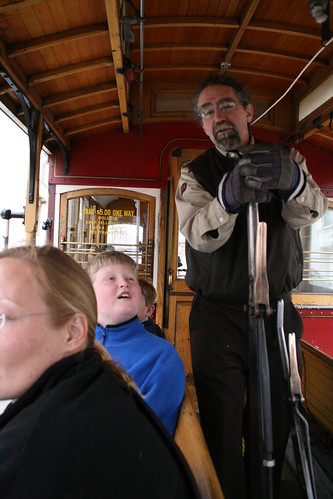The exception to Detachable Grips are what I like to think of as Attachable Grips. This concept is best exemplified by the familiar San Francisco Cable Cars. I will not go into a long description about the technology. Instead, I’d like to point you to Joe Thompson’s Cable Car Guy website which does an excellent job of explaining the technology.
In summary, the vehicles attach themselves to a below-grade cable by “picking up” or “gripping” the moving cable. This is unlike virtually every other cable technology in the world. In typical detachable systems, vehicles are attached, detachached, slowed and accelerated automatically by off-board mechanisms located within terminals and stations.
Not so in San Francisco.
San Francisco cable cars have virtually no automation. Attaching, releasing, braking and accelerating are all done manually by an operator known as a Gripman.
Beyond the desire to maintain a heritage technique, the Gripman is an essential feature of a San Francisco Cable Car given the system’s configuration and relationship to the city’s traffic.
Unlike all other cable transit systems, San Francisco’s cable cars operate within mixed traffic. This co-mingling of transportation technologies, makes automation a virtual impossibility.
The vehicles must be capable of “picking up” or “dropping” the cable at the near-instantaneous discretion of the Gripman.
As such, it’s best to classify the San Francisco cable cars as utilizing Attachable rather than Detachable Grips.
The difference is subtle, but has a significant impact on the systems’ strengths and weaknesses, a matter which I will get to in a later post. For the time being, an easy way to remember the distinction is this:
In Attachable Grip systems, attaching, detaching, acceleration and deceleration are executed on-board the vehicle in a non-automated manner.
In Detachable Grip systems, attaching, detaching, acceleration and deceleration are automated actions executed in stations or terminals off-board the vehicle.
Proceed to Grip Module, 4: Corners.
Return to Grip Module, Lesson 2: Detachable Grips
Creative Commons images David Hudson Floyd and johntrainor.



8 Comments
I find the Idea of Cable or Gondola type systems to be totally ineffective in other than optimum weather conditions. Winds play a very high factor in the safety areas. While your systems may be viable in windy conditions, I don’t see the human factor withstanding a gusting rolling pitching ride to the office. Cable cars are antiques at the best , and again these are weather dependent. Lets see the cable cars run in a foot of snow , freezing rain storms that dump several inchs at a time . Do you seriously have the engineering of these conditions factored in , For a mass transit system , speed ,and reliability are an absolute must !
I’m afraid you’re slightly mistaken. Current cable technology can operate safely in high winds of over 100 km/hr. These systems do not merely dangle from one single line. They are supported by multiple cables and do not sway.
I’d also point out that cable tech was really pioneered in alpine ski resorts where conditions are far worse than we experience in Toronto.
As for speed: There are no streetcar systems in Toronto that operate at an average speed of 15 km/hr. Lines like the Spadina dedicated right of way line, operate around 12 km/hr. Cable systems operate in a range of 25 – 40 km/hr.
As for reliability, these systems are typically contractually obligated to be available/reliable at levels above 98%.
As for capacity, these systems can carry as many as any Toronto streetcar or Light Rail system.
Believe me, I know it sounds absurd, but it works.
I agree with your conceptual view of cable cars, their low cost and energy efficiency, but what about in extremely rainy weather?
Where I live in the Tampa Bay area of Florida, it rains so hard almost every day during the summer that it doesn’t take much rain for some streets to flood. And that’s to say nothing about an infrequent hurricane.
You mentioned how cable cars can withstand 100 km/hr winds, but how can they manage in flooded streets?
That’s an excellent question, Steve, and one that I can’t answer right now, because I’ve never actually thought about it.
I personally don’t imagine street-based cable cars like in San Francisco; they’re just too dangerous. I instead imagine systems operating in a semi-elevated (no more than a couple of feet) right-of-way.
Does that solve your flooding problem? Probably not. But then again, flooding like you describe would render any transit technology (save for Arks) incapable.
An aerial system would likely be the best option for what you describe. Thanks for the question!
Personally, I like the idea. I would like some insight on the stations. How do you get off and on the able cars. What kind of infrastructure will be required for that?
Thanks
Haris
Hi Haris,
It really depends on the system. Bottom-supported systems allow users to get on and off just like any other transit technology. Aerial systems, it depends. What typically happens is that the vehicles are slowed down to what is called “crawl speed” in the stations so that people can board and alight with ease. In the event of those with a disability, children or the elderly a simple stop button is used to halt the vehicle entirely for ease of boarding.
Stations are a big issue because they are so varied. Like cable technology itself, the stations can be configured in a whole range of shapes and sizes. It’s really up to your own imagination and creativity.
Cruise around the site and the flickr group and you’ll see what I mean. I’ll try and address this topic more in the future.
Thanks so much for the interest and support!